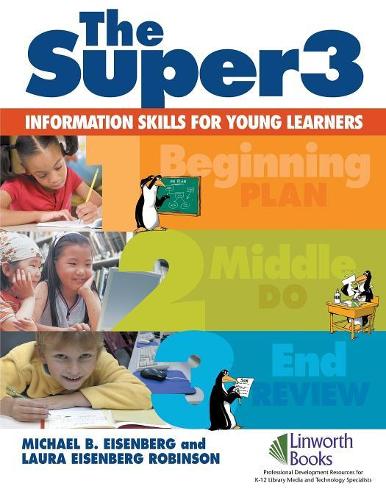
The Super3: Information Skills for Young Learners
(Paperback)
Publishing Details
The Super3: Information Skills for Young Learners
By (Author) Robert E. Berkowitz
By (author) Michael B. Eisenberg
By (author) Laura Eisenberg Robinson
Bloomsbury Publishing PLC
Linworth Publishing, Incorporated
30th August 2007
United States
Classifications
Primary and Secondary Educational
Non Fiction
025.040712
Physical Properties
Paperback
112
Width 216mm, Height 279mm
340g
Description
Use The Super3, a spin off from the widely used Big6, to help students in grades PreK-2 develop crucial problem-solving skills. Ready-to-use worksheets include explanations for daily implementation of the Super3 into the classroom. Use The Super3, a spin off from the widely used Big6, to help students in grades PreK-2 develop crucial problem-solving skills. Learn how to break down the problem-solving process so that younger students get it and remember it. Discover a process model for children to learn and use in order to be successful with the various tasks they undertake. The Super3 helps younger students recognize what they are doing so they can label and talk about their research. Provides an easy transition into the Big6. Ready-to-use worksheets include explanations for daily implementation of the Super3 into the classroom. Mike Eisenberg and Laura Eisenberg Robinson have adapted the widely used Big6 research approach for students in grades PreK-2. The Super3 uses the three simple steps: Plan, Do, Review.
Reviews
Super3: Information Skills for Young Learners outlines the process of research from beginning to middle to end but for younger students than those who would use the Big6. The authors, father and daughter, are well versed in the process having written about the Big6 for older students, and presented the information at conferences and workshops. Here they take on the younger students who are just beginning to use libraries, books and other materials to gather information for research projects. Clearly the steps are the same: plan, do, and review. This framework, though seemingly quite simplistic, is the crux of research no matter the grade level, even graduate students follow these steps. Teachers are given support materials, some not so great song lyrics to help students remember what to do, plenty of ideas. The authors include a chart showing how the Big3 compares with the Big6 which makes it easy to understand terminology. From overview to worksheets and examples, classroom teachers and libraries who teach research skills (don't we all) will find this a valuable addition to their professional libraries. * Library Media Connection *
Author Bio
Michael B. Eisenberg is dean emeritus and professor at the Information School of the University of Washington. Laura Eisenberg Robinson is the special education teacher/Big 6 project manager at Seattle Public Schools in Seattle, WA.
